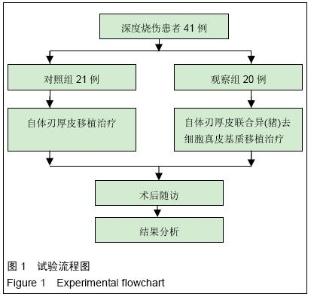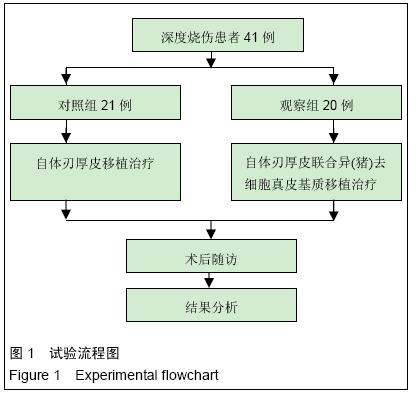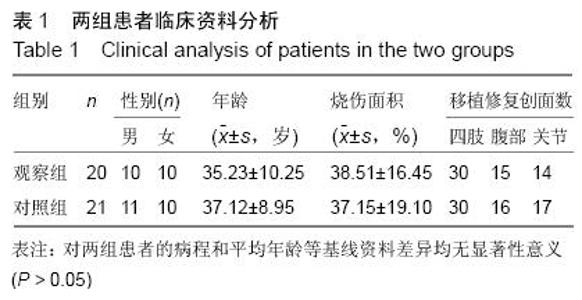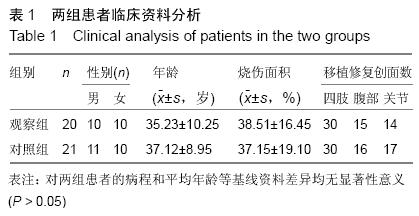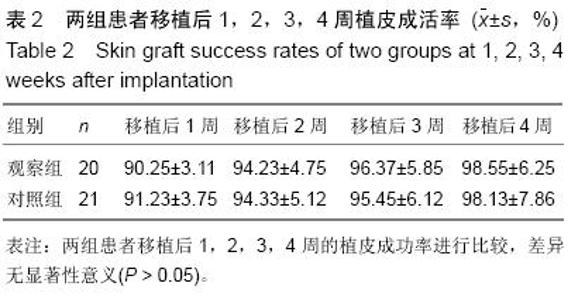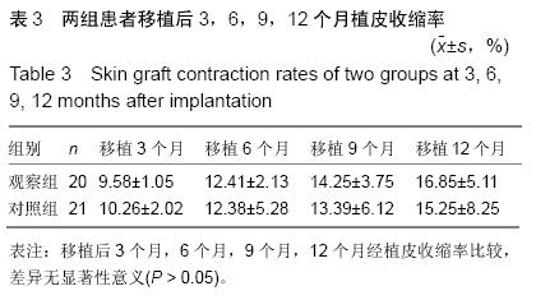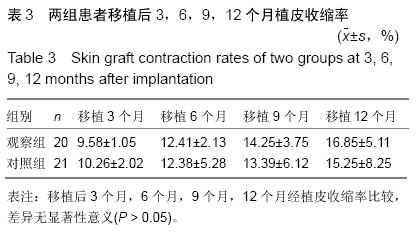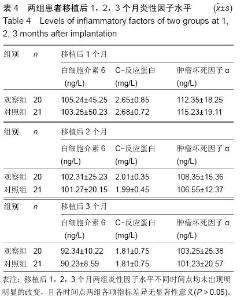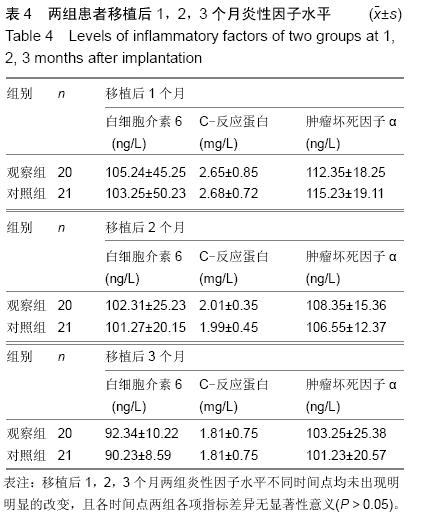| [1] 柴家科,刘强,冯瑞,等.异种(猪)去细胞真皮基质与自体微粒皮及自体刃厚皮复合移植的比较研究[J].解放军医学杂志,2004,29(8):714-716, 721.[2] 刘强,鲁大路,孟爱华,等.异种(猪)去细胞真皮基质修复深度烧伤创面的临床应用[J].中华损伤与修复杂志(电子版), 2008,3(4):462-468.[3] 京萨,柴家科,陈敏亮,等.自制异种猪去细胞真皮修复切除瘢痕区创面的愈合质量[J].中国临床康复, 2005,9(22): 128-129.[4] 谭红,王晖,张伟,等.移植异种去细胞真皮基质的组织学观察[J].中华损伤与修复杂志(电子版),2007,2(1):40-42.[5] Komatsu I, Yang J, Zhang Y, et al. Interstitial engraftment of adipose-derived stem cells into an acellular dermal matrix results in improved inward angiogenesis and tissue incorporation. J Biomed Mater Res A. 2013;101A(10):2939-2947.[6] 马绍英,李宝明,董丽,等.异种(猪)无细胞真皮基质的制备及体外生物相容性[J].中国组织工程研究与临床康复, 2009,13(38):7424-7428.[7] Choi K, Kang BJ, Kim H, et al. Low-level laser therapy promotes the osteogenic potential of adipose-derived mesenchymal stem cells seeded on an acellular dermal matrix. J Biomed Mater Res B Appl Biomater. 2013;101B(6):919-928.[8] Huang SP, Hsu CC, Chang SC, et al. Adipose-derived stem cells seeded on acellular dermal matrix grafts enhance wound healing in a murine model of a full-thickness defect. Ann Plastic Surg. 2012;69(6): 656-662.[9] Sahin I, Ozturk S, Deveci M, et al. Experimental assessment of the neo-vascularisation of acellular dermal matrix in the wound bed pretreated with mesenchymal stem cell under subatmospheric pressure. J Plast Reconstr Aesthet Surg. 2014;67(1): 107-114. [10] 余於荣,闵定宏,刘上基,等.含银异种脱细胞真皮基质的试验研究[J].中华烧伤杂志,2006,22(4):296-300.[11] 杨燕妮,彭代智,伍素华,等.异种无细胞真皮制备方法比较及在移植中的意义[J].中国临床康复, 2004,8(23): 4772-4773.[12] 张海军,王晓勇.脱细胞异种真皮基质在烧伤Ⅱ°创面的临床应用[J].内蒙古医学杂志,2012,44(8):974-975.[13] 陈娇,但年华,肖世维等.季铵盐型脱细胞猪真皮基质的研究[J].功能材料,2014,(14):14103-14107.[14] Al-Hezaimi K, Rudek I, Al-Hamdan KS, et al. Efficacy of acellular dermal matrix and coronally advanced flaps for the treatment of induced gingival recession defects: a histomorphometric study in dogs. J Periodontol. 2013;84(8):1172-1179. [15] 贾生贤,金曙雯,陈玉英,等.无细胞真皮基质的研制[J].实用美容整形外科杂志,2000,11(2):59-62.[16] 赵京玉,柴家科,宋慧锋,等.透明质酸对复合移植皮肤组织生物力学性能影响的试验观察[J].中华医学杂志, 2012, 92(24):1719-1722.[17] Guo R, Teng J, Xu S, et al. Comparison studies of the in vivo treatment of full-thickness excisional wounds and burns by an artificial bilayer dermal equivalent and J-1 acellular dermal matrix. Wound Repair Regen. 2014;22(3):390-398. [18] 温春泉,张国安,宁方刚,等.异种脱细胞真皮基质制备方法的改进[J].中国组织工程研究与临床康复, 2010,14(41): 7635-7638.[19] 王磊,谭谦,宁官森,等.脱细胞异种真皮基质与自体薄皮片复合移植的试验研究及临床应用[J].现代医学, 2005, 33(6): 363-365.[20] Ribeiro LL, Bosco AF, Nagata MJ, et al. Influence of bioactive glass and/or acellular dermal matrix on bone healing of surgically created defects in rat tibiae: a histological and histometric study. Int J Oral Maxillofac Implants. 2008;23(5):811-817. [21] Park SH, Wang HL. Management of localized buccal dehiscence defect with allografts and acellular dermal matrix. Int J Periodontics Restorative Dent.2006;26(6): 589-595. [22] Nunez J, Caffesse R, Vignoletti F, et al. Clinical and histological evaluation of an acellular dermal matrix allograft in combination with the coronally advanced flap in the treatment of miller class I recession defects: an experimental study in the mini-pig. J Clin Periodontol. 2009; 36(6):523-531. [23] 姜笃银,钱春华,周兵,等.不同脱细胞方法对无细胞真皮基质抗原成分的影响[J].中国临床康复,2005,9(6):35-37.[24] 赵筱卓,宁方刚,张国安,等.猪脱细胞真皮基质中导入透明质酸后对真皮降解率的影响[J].中华烧伤杂志, 2011, 27(2): 63-164.[25] 吴敏,刘惕,王龙村,等.磨痂加异种脱细胞真皮基质覆盖术的临床应用[J].江苏医药,2005,31(10):785-786.[26] 刘强,冯瑞,孟爱华,等.异种去细胞真皮基质在体内转归的初步研究[J].中国危重病急救医学,2006,18(1):49-50.[27] Brzezienski MA, Jarrell JA, Mooty RC, et al. Classification and management of seromas in immediate breast reconstruction using the tissue expander and acellular dermal matrix technique. Ann Plastic Surg. 2013;70(5):488-492. [28] 陈炯,柴家科,韩春茂,等.去细胞真皮基质与自体皮复合移植的临床应用及远期随防[C].2007年浙江省医学会第十七届烧伤外科学术会议论文集.2007.[29] 冯祥生,谭家驹,阮树斌,等.脱细胞猪真皮基质覆盖治疗人深Ⅱ度烧伤[J].第一军医大学学报,2002,22(9):844-848.[30] 余於荣,闵定宏,刘上基,等.含银脱细胞真皮基质抗性的试验研究[J].江西医学院学报,2007,47(3):20-26.[31] Martin L, O'Donoghue JM, Horgan K, et al. Acellular dermal matrix (ADM) assisted breast reconstruction procedures: Joint guidelines from the Association of Breast Surgery and the British Association of Plastic, Reconstructive and Aesthetic Surgeons. Eur J Surg Oncol. 2013;39(5):425-429. [32] Liem PH, Morimoto N, Ito R, et al. Autologous skin reconstruction by combining epidermis and acellular dermal matrix tissue derived from the skin of giant congenital melanocytic nevi. J Artif Organs. 2013; 16(3):332-342. [33] 钱铁石,钱桂芳,潘银根,等.异种无细胞真皮基质与自体刃厚皮复合移植的临床应用[J].临床医学, 2003,23(1):54-55.[34] 陈晓东,施彦,杨荣华,等.异种(猪)脱细胞真皮基质对大鼠深Ⅱ度烧伤创面肿瘤坏死因子-α、白细胞介素-8、白细胞介素-1表达的影响[J].中华损伤与修复杂志(电子版), 2014,(2):137-143.[35] 李武全,邱啸臣,刘军等.大面积烧伤微粒皮移植应用脱细胞猪皮与异体皮作为覆盖物的对比研究[J].第二军医大学学报,2012,33(11):1207-1211.[36] 谭谦,邹忠桃,宁官森,等.低浓度胰蛋白酶消化加反复冻融法制备猪脱细胞真皮基质[J].中华烧伤杂志, 2004,20(6): 354-356.[37] 马忠锋,柴家科,杨红明,等.不同方法制备猪脱细胞真皮基质及创面移植的试验研究[J].中国危重病急救医学, 2005, 17(2):92-94.[38] Zhang J, Wang GY, Xiao YP, et al. The biomechanical behavior and host response to porcine-derived small intestine submucosa, pericardium and dermal matrix acellular grafts in a rat abdominal defect model. Biomaterials. 2011;32(29):7086-7095. [39] 陈善伟,邓李敏,李东,等.异种脱细胞真皮基质一次性包扎治疗Ⅱ度烧伤32例的临床观察[J].广西医学, 2010,32(9): 1076-1078.[40] 周彪,王凌峰,张军,等.异种羊脱细胞真皮基质与自体微粒皮复合移植后创面愈合及COX-2、VEGF的表达研究[J].中华损伤与修复杂志(电子版),2009,4(3):257-269.[41] Yu G, Ye L, Tan W, et al. A novel dermal matrix generated from burned skin as a promising substitute for deep?degree burns therapy. Mol Med Rep. 2016.[42] Zhang J, Huang X. Levels of IL-4 and IFN-γ in serum of mice after the sheep skin acellular dermal matrix transplant. Zhong Nan Da Xue Xue Bao Yi Xue Ban. 2016;41(1):51-57.[43] ?abu? W, Kawecki M, Glik J, et al. Own experience from the use of a substitute of an allogeneic acellular dermal matrix revitalized with in vitro cultured skin cells in clinical practice. Pol Przegl Chir. 2015;87(10): 513-521.[44] Guo ZQ, Qiu L, Gao Y, et al. Use of porcine acellular dermal matrix following early dermabrasion reduces length of stay in extensive deep dermal burns. Burns. 2016.[45] Beaudoin Cloutier C, Guignard R, Bernard G, et al. Production of a Bilayered Self-Assembled Skin Substitute Using a Tissue-Engineered Acellular Dermal Matrix. Tissue Eng Part C Methods. 2015; 21(12):1297-1305.[46] Verbelen J, Hoeksema H, Pirayesh A, et al. Exposed tibial bone after burns: flap reconstruction versus dermal substitute. Burns. 2016;42(2):e31-e37. |
